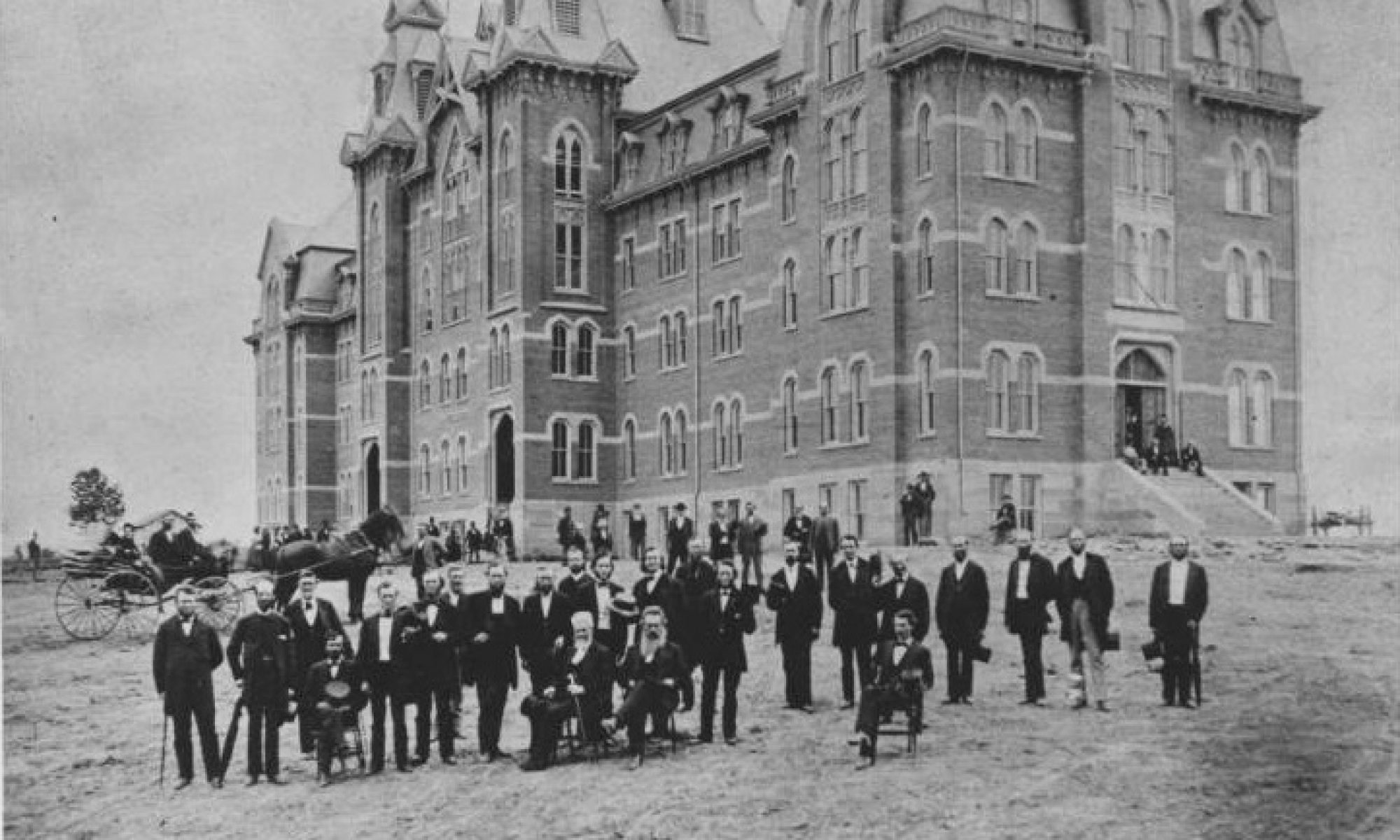Introduction | Buchtel Hall Takeover | Anti-Apartheid Protests | Protests for Equality | Conclusion
Protests for Equality
In the early 1990s, Black Americans renewed their fight against racism and struggle for equality on the campus and across the nation. Many peaceful but powerful protests took place in 1992, mostly organized by Black United Students (BUS). Most rallies focused on equal treatment and opportunities for Blacks on campus. Coincidentally, some of them focused on the same or similar demands put forth by BUS during the Buchtel Hall Takeover of 1969, namely, a Black Studies Program and Black Cultural Center. While these existed on campus, mostly as an outcome of the takeover, BUS fought for additional funding, support, and recognition of these programs in the early 1990s.
Other protests during this time focused on Governor George Voinovich’s plan to cut funding for higher education, which would have raised tuition and put additional financial strains on UA’s students, particularly Black students. Other non-violent protests broke out on campus and spilled over into the city of Akron due to the acquittal of four police officers who were being charged with the senseless beating of Rodney King in Los Angeles in 1992 and the resulting L.A. riots. Tensions on campus and across the county were also exacerbated by the upcoming 1992 presidential election between Republican incumbent George H. W. Bush and Democratic nominee Bill Clinton. The photographs and newspaper stories below from Archival Services of University Libraries recount this period of social and political unrest and continued calls for racial equality and social justice on our campus, in our community, and across the country, and the changes initiated due to these events.
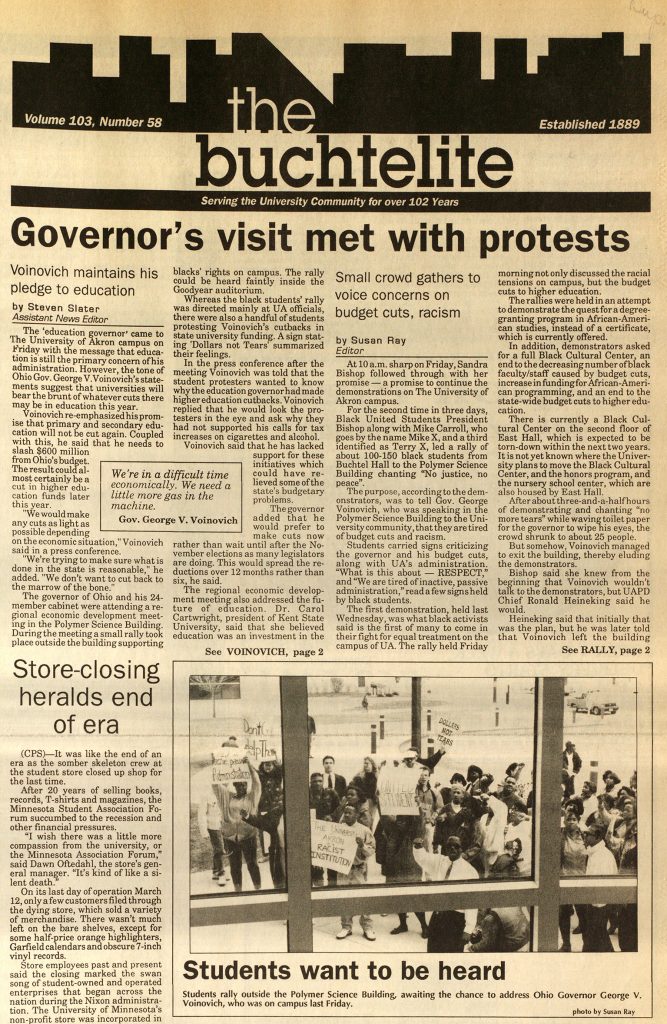
From The Buchtelite Collection in Archival Services of University Libraries
On April 3, 1992, Ohio Governor George V. Voinovich and his cabinet attended a regional economic development meeting held in the Polymer Science Building at The University of Akron, where he reiterated his program to cut $600 million from the state’s budget, mostly from higher education. Students at UA and across the state were going to bear the brunt of the cuts, which put particular strain on Black students. Therefore, a rally occurred outside the building supporting black rights on the campus and protesting Voinovich’s cuts in state university funding. The demonstration was coordinated by BUS and led by its outspoken President Sandra Bishop and Vice President Mike Carroll. The rally began at Buchtel Hall with about 150 to 200 Black students who marched to the Polymer Building chanting “no justice, no peace!”
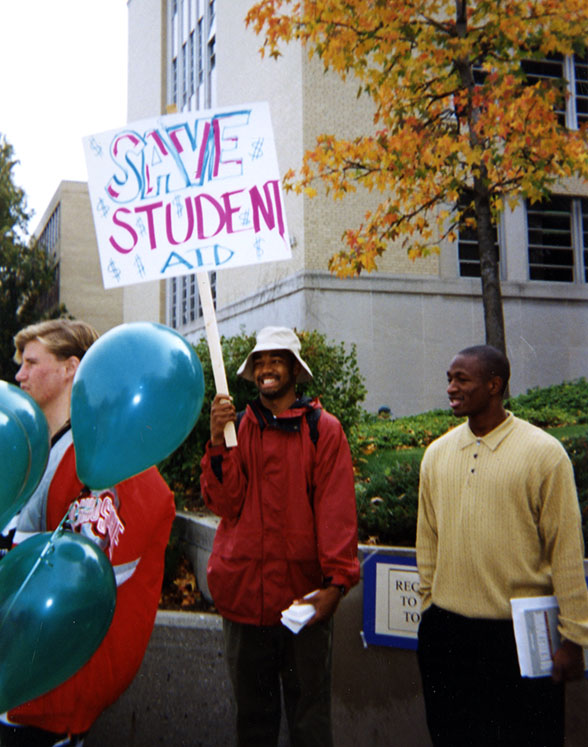
From The University of Akron Tel-Buch Office Records in Archival Services of University Libraries
A Black student protestor holds a sign that says “Save Student Aid,” probably during one of three rallies held in April 1992 to protest Governor Voinovich’s cuts to higher education and advocate for equal treatment on campus. The rallies were also held in an attempt to demonstrate the desire for a degree-granting program in African American Studies, instead of a certificate, which was currently offered, and for a full Black Cultural Center. Other desires were for an end to the decreasing number of black faculty and staff caused by budget cuts and an increase in funding for programming.
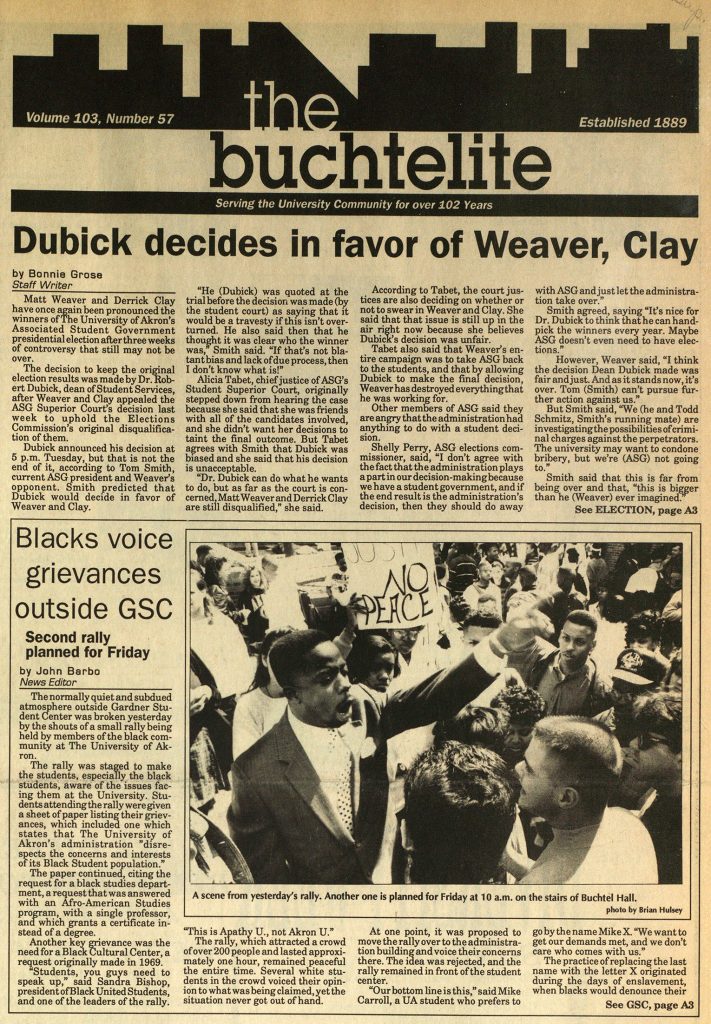
From The Buchtelite Collection in Archival Services of University Libraries
This front page of the Buchtelite shows a rally that occurred outside Gardner Student Center on April 8, 1992. The purpose of the protest was to raise awareness among Black students of the issues and challenges facing them at the University and to attract attention from the administration to their concerns and interests, including the creation of a Black Studies Department. Although a Black Studies Program was created after the Buchtel Hall Takeover in 1969, it was only a certificate program, not a degree granting program as had been originally intended. Another key grievance was the call for a Black Cultural Center (BCC), another request originally made in 1969. While the BCC was created in 1973, the black students on campus in the early 1990s felt that it was not getting the support in terms of funding and facilities it needed and deserved. Finally, the rally advocated for the need for greater awareness of Black history.
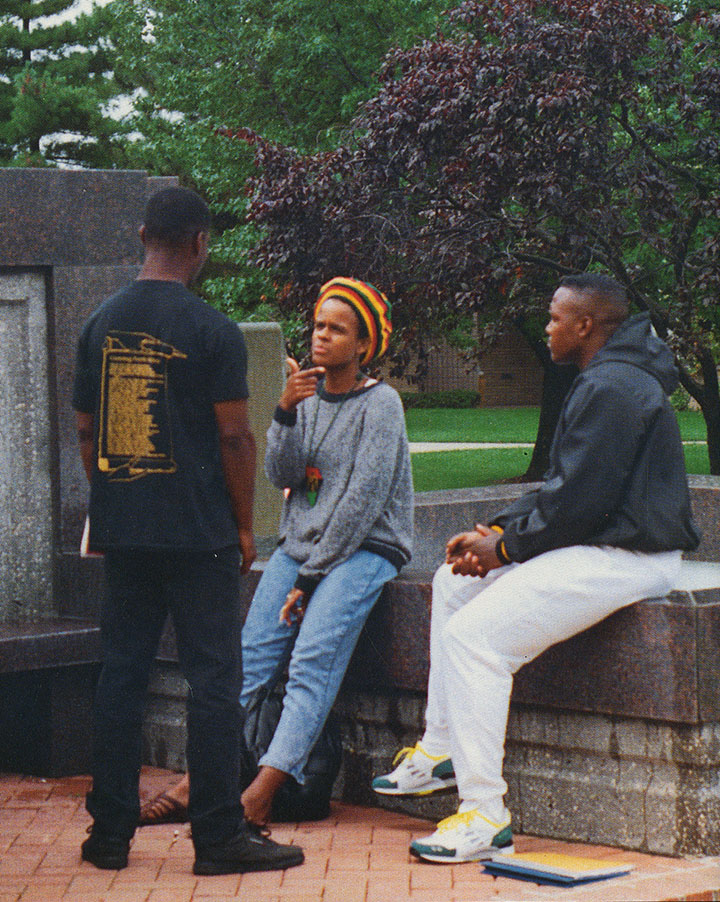
From the Tel-Buch Collection in Archival Services of University Libraries
Several Black students talk on campus at the Dorothy Garrett Martin fountain next to Bierce Library. In the early 1990s, the number of Black students enrolled at the University was on the rise, mostly due to the administration of President Bill Muse, who made a concerted effort to recruit Black students. Minority enrollment rose to 11.72% in Fall 1992, with approximately 9.5% (or roughly 2,489) being Black. As the Black student population at the University increased, so did the call for equal rights and opportunities on campus for these students.
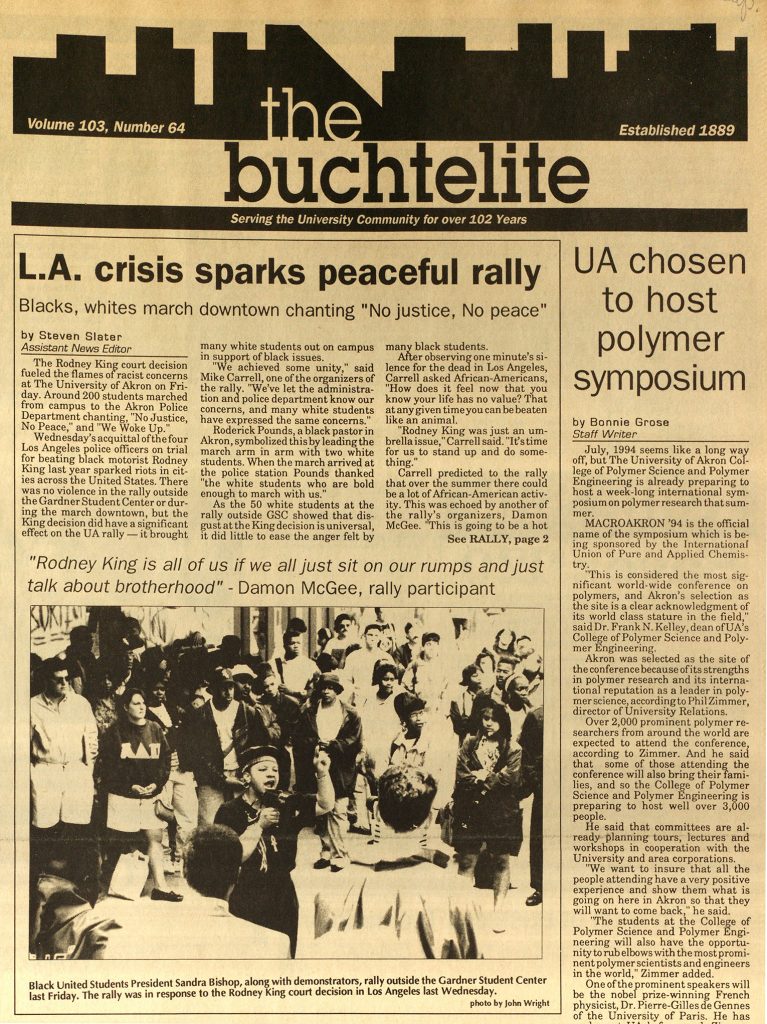
From The Buchtelite Collection in Archival Services of University Libraries
On March 3, 1991, Rodney King, a Black motorist who was involved in a high speed chase while under the influence, became the victim of police brutality after several members of the Los Angeles Police Department stopped him and used excessive force after he tried to resist arrest. After a bystander filmed the beating and sent it to the media, several police officers were brought to trial. Hours after three of the four officers involved in the beating were acquitted by the jury on April 29, 1992, the 1992 Los Angeles riots began and lasted for six days. Smaller riots erupted in cities across the nation, in addition to protests, including the one mentioned on this front page of the Buchtelite that occurred on May 1, 1992, the day after the acquittals.
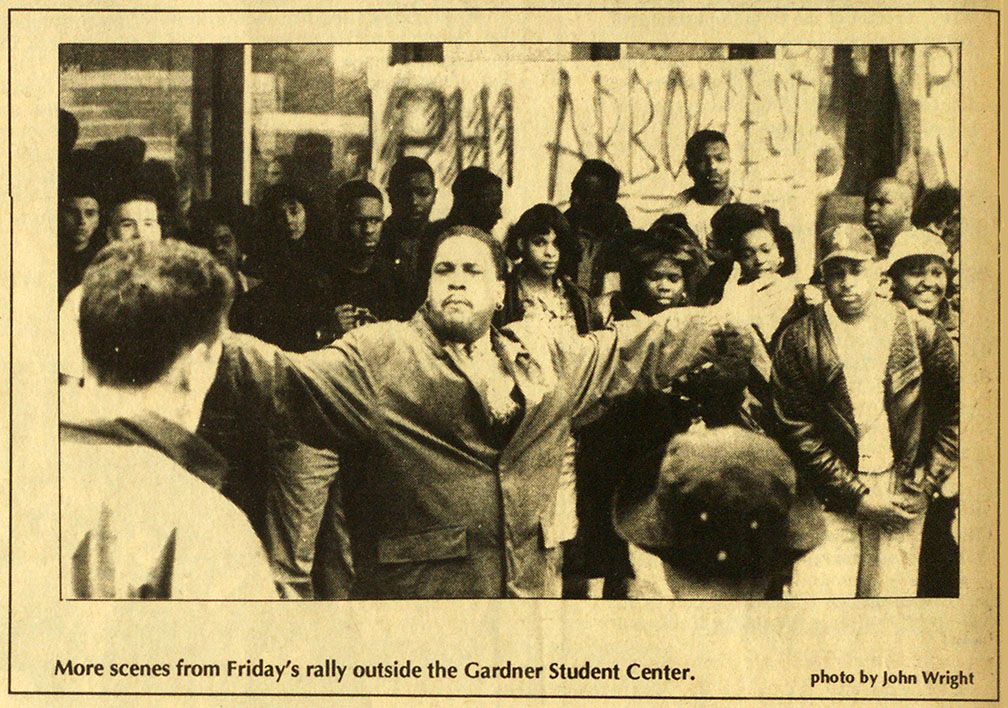
From The Buchtelite Collection in Archival Services of University Libraries
During the protest held on the UA campus on May 1, 1992, approximately 200 students marched from the Gardner Student Center on campus to the Akron Police Department downtown chanting “No Justice, No Peace” and “We Woke Up.” During the peaceful rally, many students came out to support Black issues, including calls for an end to racism and police brutality.

From the Tel-Buch Collection in Archival Services of University Libraries
Members of Black United Students sit at a table at a recruitment event in the Gardner Student Center. BUS members spearheaded most of the protests for racial equality and social justice that took place on campus in the early 1990s. They also hosted several events to discuss racism on campus, including an open mic forum at Summit Lounge on March 10, 1992. That program, co-sponsored by the University Program Board, addressed such topics as differences in Black and white cultural history and mandatory cultural diversity classes. Other events on campus that year, including a panel discussion titled “King: The Day Justice Died,” which was sponsored by Alpha Phi Alpha Fraternity, included strong participation by BUS members.
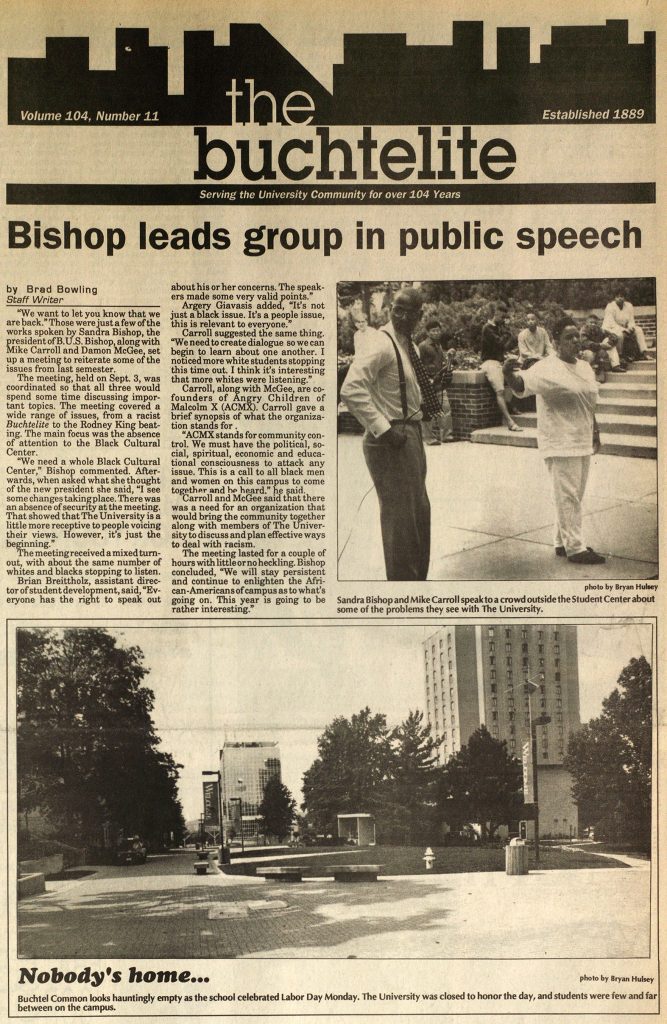
From The Buchtelite Collection in Archival Services of University Libraries
When classes resumed in the fall of 1992, BUS, led by Sandra Bishop, Mike Carroll, and Damon McGee, organized additional rallies on campus to bring attention to African American issues, including the one reported in this Buchtelite issue that took place on September 3. The main focus of the forums were the discussion of important topics including the Rodney King beating, equal representation for students of color in the Buchtelite, and support of the Black Cultural Center. Carroll and McGee, who were also known as Mike X and Damon X, respectively, were cofounders of Angry Children of Malcolm X (ACMX), which had the purpose of bringing the community and the campus, including the administration, together to increase dialogue on issues of racism on campus and in the community. Carroll and McGee’s cause may have been influenced by the American biopic “Malcolm X” by director Spike Lee that premiered that year.

From the Black Cultural Center Records in Archival Services of University Libraries
One of the results of the numerous protests and calls for action that took place on the campus and throughout the nation in the wake of the Rodney King incident and the L.A. riots was the implementation of several programs on campus to combat violence and racism. One of the programs was the Community Violence Forum, including the event advertised by this flyer which took place in November 1992 in the Goodyear Polymer Building on the UA campus. The forum was sponsored by UA’s Office of Minority Affairs, the Black Cultural Center, Black Greek Council, and UA’s Police Department, with additional support from the city of Akron and numerous Akron community organizations, especially the East Akron Community House.
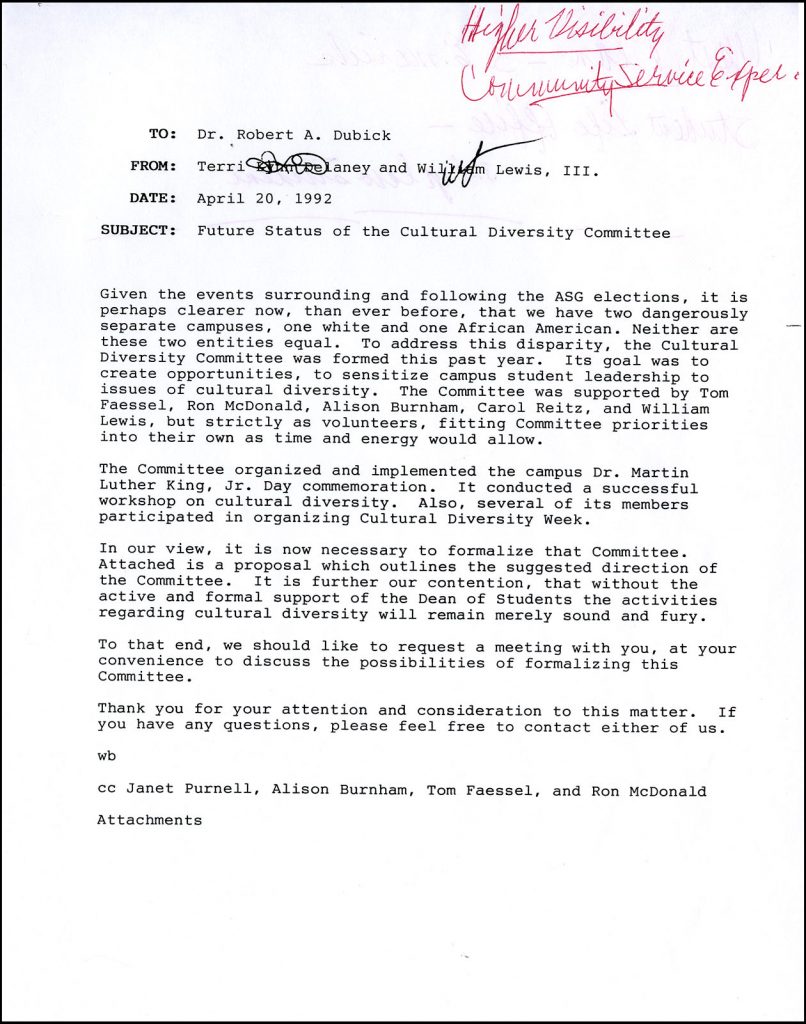
From the Black Cultural Center Records in Archival Services of University Libraries
Many significant initiatives were launched in 1992, including The University of Akron’s Cultural Diversity Committee. This letter from Terri DeLaney and William Lewis, III of the Black Cultural Center to Robert A. Dubick, dean of Student Services, outlines its purpose, which was to address the disparity between Black and white students on campus and to sensitize the University’s students to cultural diversity. It also organized and sponsored programs including the annual Martin Luther King, Jr. Day commemoration and Cultural Diversity Week. They also hosted workshops on cultural diversity, which led to cultural diversity training for all incoming students and staff.

From the Black Cultural Center Records in Archival Services of University Libraries
One of incoming President Peggy Gordon Elliot’s initiatives in the Fall of 1992 was the creation of several new committees, including the Diversity Council, as reported in this article in a 1992 edition of the UA Update. The purpose of the council was to provide an important forum for finding and implementing ways to make every member of the University community feel welcome and appreciated and to celebrate our diversity. The committee, which consisted of faculty, staff. students, and community members, also sought to find problems and provide remedies.
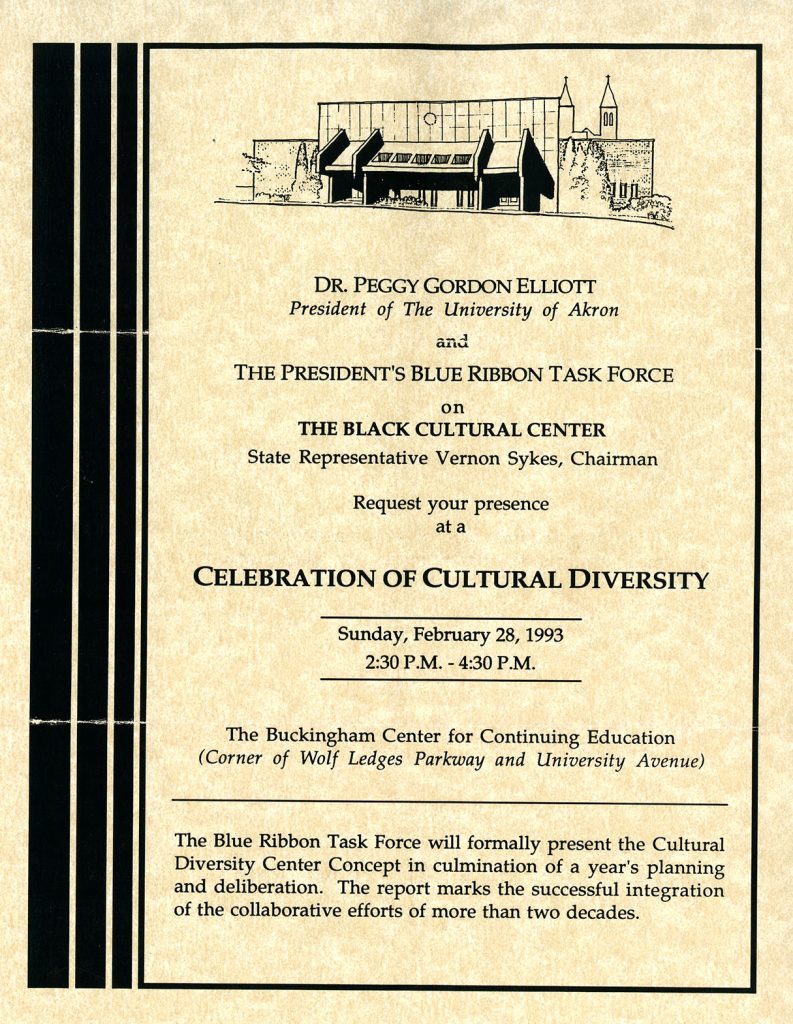
From the Black Cultural Center Records in Archival Services of University Libraries
Following the tumultuous year of 1992, the University and city of Akron undertook numerous initiatives to address the problem of racism on the campus and in the community. One initiative was the President’s Blue Ribbon Task Force on the Black Cultural Center (now the Multicultural Center) to present the Cultural Diversity Center Concept. This was one of many initiatives launched by newly appointed President Elliot to address student concerns and the calls for racial equality and social justice on the campus and in the community at that time.

